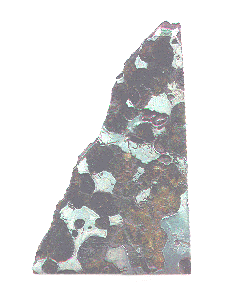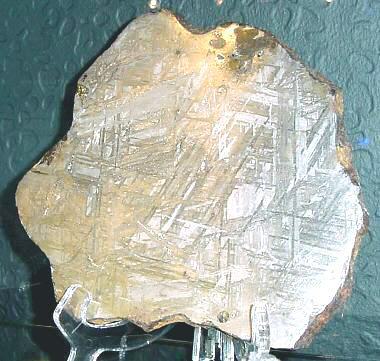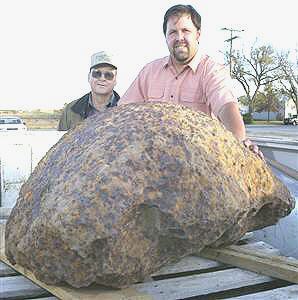PallasiteOne of two main classes of stony-iron meteorite, the other being mesosiderites. Pallasites are igneous in nature and characterized by crystals of olivine, sometimes peridot (green gem quality clear olivine crystals), embedded in a matrix of Fe-Ni metal. The type specimen, weighing 680 kg, was found in the mountains near Click on Term to Read More, MG (main-group), anomalous metalElement that readily forms cations and has metallic bonds; sometimes said to be similar to a cation in a cloud of electrons. The metals are one of the three groups of elements as distinguished by their ionization and bonding properties, along with the metalloids and nonmetals. A diagonal line drawn Click on Term to Read More composition
high-Δ17O subgroup (see details on the Imilac page)

Found 1882, known before
37° 36′ N., 99° 12′ W. approx. Soon after Frank and Mary Kimberly made their home on the Kansas prairie in Kiowa County, Mary began collecting the black iron rocks she found around the farm believing that they resembled the meteoriteWork in progress. A solid natural object reaching a planet’s surface from interplanetary space. Solid portion of a meteoroid that survives its fall to Earth, or some other body. Meteorites are classified as stony meteorites, iron meteorites, and stony-iron meteorites. These groups are further divided according to their mineralogy and Click on Term to Read More she had seen as a child. Then for years, she tried to have her large pile of iron rocks authenticated by a professional, without success. Finally, a geologist from Washburn College, Dr. Cragen, recognized them as meteorites and purchased a large portion of her collection. This began a profitable business for the Kimberly family selling meteorites from their ‘Kansas Meteorite Farm’.
In 1929, Harvey Nininger explored an old wallow on the Kimberly farm and discovered that it was a 36 x 55-foot rimmed
impact craterCrater formed by high-speed impact of a meteoroid, asteroid, or comet on a solid surface. Craters are a common feature on most moons (an exception is Io), asteroids, and rocky planets, and range in size from a few cm to over 1,000 km across. There is a general morphological progression Click on Term to Read More containing numerous pallasite masses. A total weight of over 1.5 tons of this weathered pallasite has been recovered in and around the Kimberly farm during the past years, many individual masses weighing hundreds of pounds. A half-ton mass was unearthed in 1948 near the Kimberly farm. Due to an extended period buried in moist soil, much of the material has become
oxidizedOxidation and reduction together are called redox (reduction and oxidation) and generally characterized by the transfer of electrons between chemical species, like molecules, atoms or ions, where one species undergoes oxidation, a loss of electrons, while another species undergoes reduction, a gain of electrons. This transfer of electrons between reactants Click on Term to Read More, and the completely oxidized fragments were named meteorodes by Nininger.
Brenham iron artifacts, including hand tools and personal ornaments, have been found associated with the Hopewell Mounds in Ohio, which are located about 1,400 km to the east of the Brenham
craterBowl-like depression ("crater" means "cup" in Latin) on the surface of a planet, moon, or asteroid. Craters range in size from a few centimeters to over 1,000 km across, and are mostly caused by impact or by volcanic activity, though some are due to cryovolcanism. Click on Term to Read More. The Hopewell Indians, whose culture ended about 500 B.C., considered this material sacred, and many meteoritic objects were used ceremonially. Objects were found on the alters of several of the mounds, and some were associated with human skeletons.
In a 3-dimensional study of Brenham utilizing Electron Tomography Segmentation, it was revealed that all of the
olivineGroup of silicate minerals, (Mg,Fe)2SiO4, with the compositional endpoints of forsterite (Mg2SiO4) and fayalite (Fe2SiO4). Olivine is commonly found in all chondrites within both the matrix and chondrules, achondrites including most primitive achondrites and some evolved achondrites, in pallasites as large yellow-green crystals (brown when terrestrialized), in the silicate portion Click on Term to Read More is interconnected, as is most of the FeNi-metal (Spinsby
et al., 2008). The remaining constituents,
troiliteBrass colored non-magnetic mineral of iron sulfide, FeS, found in a variety of meteorites. Click on Term to Read More and
schreibersiteNi-Fe phosphide mineral, (Fe,Ni)3P, yellowish in color and predominantly found in iron and stony-iron meteorites. Schreibersite can also be found in a variety of other meteorites including some acapulcoites, aubrites, enstatite chondrites and achondrites, lunars, ureilites, winonaites and a smattering of other meteorite types like CM, CO and CB. Schreibersite Click on Term to Read More, occur as a large but discontinuous network with some isolated pockets. The volume of olivine in their sampling (67%) approximates well the volume expected given a scenario of accumulation through settling from an established
silicateThe most abundant group of minerals in Earth's crust, the structure of silicates are dominated by the silica tetrahedron, SiO44-, with metal ions occurring between tetrahedra). The mesodesmic bonds of the silicon tetrahedron allow extensive polymerization and silicates are classified according to the amount of linking that occurs between the layer. It was presumed these olivine crystals then recrystallized to form a continuous network. Thereafter, troilite and schreibersite were infused throughout the solid olivine
matrixFine grained primary and silicate-rich material in chondrites that surrounds chondrules, refractory inclusions (like CAIs), breccia clasts and other constituents. Click on Term to Read More by a late-stage sulfide–phosphide-bearing melt prior to complete solidification of the pallasite.
Since cooling rates are the same for both rounded and angular olivines among main-group pallasites, and Brenham metal is also low in Ir, Yang
et al. (2010) proposed that the olivines were annealed near the core-mantle boundary prior to the glancing impact that disrupted the body, and thereafter the residual molten metal from the outer
coreIn the context of planetary formation, the core is the central region of a large differentiated asteroid, planet or moon and made up of denser materials than the surrounding mantle and crust. For example, the cores of the Earth, the terrestrial planets and differentiated asteroids are rich in metallic iron-nickel. Click on Term to Read More solidified around the rounded olivines. Alternatively, Boesenberg
et al. (2012) argue that the rounding of the olivine crystals occurs primarily from resorption at high temperatures (above ~1250°C) in the presence of silicate melt. Formation scenarios and classification schemes for the main-group pallasites can be found on the
Imilac page.
Studies of Brenham involving cosmogenic
nuclideA nuclear species characterized by Z protons and N neutrons. Click on Term to Read More production rates have resolved a CRE age of 156 (±8) m.y., a pre-atmospheric radius of ~4–6 m, and a minimum pre-atmospheric mass of ~500 (±100) tons, of which 6,800 kg have been recovered (Honda
et al., 2002; Kollar
et al., 2003). Homma and Iizuka (2018) obtained a Hf–W model age for Brenham of 2.0 (±2.9) m.y. after
CAIsSub-millimeter to centimeter-sized amorphous objects found typically in carbonaceous chondrites and ranging in color from white to greyish white and even light pink. CAIs have occasionally been found in ordinary chondrites, such as the L3.00 chondrite, NWA 8276 (Sara Russell, 2016). CAIs are also known as refractory inclusions since they Click on Term to Read More, which is consistent with the ages of other main-group pallasites derived through other isotopic chronometers. In addition, Homma and Iizuka (2018) recognized that the age accords well with other magmatic iron groups, and the ε
183W value indicates an
accretionAccumulation of smaller objects into progressively larger bodies in the solar nebula leading to the eventual formation of asteroids, planetesimals and planets. The earliest accretion of the smallest particles was due to Van der Waals and electromagnetic forces. Further accretion continued by relatively low-velocity collisions of smaller bodies in the Click on Term to Read More location in the non-carbonaceous (inner
Solar SystemThe Sun and set of objects orbiting around it including planets and their moons and rings, asteroids, comets, and meteoroids.) reservoir.
Based on recent excavations from Pleistocene
strataOriginally horizontal layers of rock., the terrestrial age of Brenham has been estimated to be 10 t.y. (R. Hegeman,
Associated Press, 2006). The photo above is a partial slice of Brenham weighing 42.4 g. The olivines near the outer edge have become darkened, possibly as a result of weathering or by the heat of atmospheric entry, while those farther away from this zone maintain their orange color. The photo below shows a dinner plate-sized, 2,100 g slice containing virtually no olivines that was acquired by Jay Piatek.

Photo courtesy of the Dr. J. Piatek Collection On Sunday, October 16, 2005, after securing lease agreements to search the properties encompassing the Brenham strewnfield, meteorite hunter Steve Arnold and geologist/attorney Phil Mani instituted a search by metal
detectorAny device used to sense the passage of a particle or photon (x-ray, γ-ray, etc.). X-rays can be detected using sealed-gas proportional, gas-flow proportional detectors, and Li-drifted Si semiconductor detectors. A Li-drifted Ge detector is used to count γ-rays in the laboratory. Click on Term to Read More on the farm of Allen and Mary Binford. Prompted by a strong signal, they dug down to
findMeteorite not seen to fall, but recovered at some later date. For example, many finds from Antarctica fell 10,000 to 700,000 years ago. Click on Term to Read More an oriented 1,430 pound (650 kg) Brenham mass buried 88 inches underground. This is the largest Brenham mass recovered to date, dubbed ‘King of the Pallasites’. Many additional masses continue to be unearthed by the team. The photos below show the final stage of its excavation, and below that, a close-up of Steve Arnold with his prize (Allen Binford behind).

Photo courtesy of Phil Mani

Photo courtesy of G. Marc Benavidez/AP










